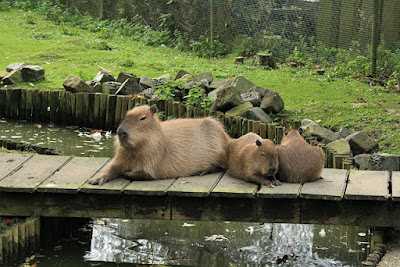The capybara: nature's largest rodent
The capybara (Hydrocheris hydrocheris) is a fascinating and extraordinary creature, often referred to as "nature's largest rodent". This charismatic animal found in South America has several interesting characteristics that make it a remarkable species. From its social behavior to its ecological importance, the capybara has attracted the attention of animal lovers and researchers alike. In this article, we'll delve deeper into the world of capybaras, exploring their physical characteristics, behavior, habitat, and the essential role they play in our ecosystem.
Physical characteristics
Capybaras are truly giants among rodents. They are characterized by a strong, barrel-shaped body, short legs and partially webbed feet, which make them excellent swimmers. Typically, they stand about 1 to 1.5 feet tall at the shoulder and can reach lengths of 3.5 to 4.5 feet, excluding their tails, which measure an additional 12 to 20 inches. Weighing in at 77 to 145 pounds, capybaras are truly impressive in size.
Their fur is short, coarse, and ranges in color from reddish-brown to more yellowish-brown. Their front feet are slightly webbed and their hind feet are fully webbed, a unique adaptation that aids in swimming and navigating through the aquatic environment with ease.
Behavior and social structure
One of the most interesting aspects of capybaras is their highly social nature. They are highly sociable animals, living in groups called "herds" or "groups". These groups can consist of 10 to 40 individuals, although some large gatherings of over 100 capybaras have been observed in some areas.
A complex social structure exists within these groups. Capybaras are known for their friendly and peaceful interactions, often engaging in mutual grooming and playful behavior. Social bonds are essential to their well-being, and they display remarkable cooperation and communication skills to maintain group harmony.
Capybaras have even been observed forming symbiotic relationships with other species, such as birds that clean insects off their backs, providing grooming services to the capybara while providing food.
Accommodation and distribution
Capybaras are semi-aquatic creatures that inhabit a wide variety of environments throughout South America. They are usually found in low-lying areas near rivers, lakes, marshes and swamps. The abundance of water is essential to their survival, as they depend on it not only for drinking but also to avoid predators and to regulate body temperature in hot climates.
These remarkable creatures can be found in countries such as Brazil, Venezuela, Colombia, Argentina, Paraguay, and Uruguay, but their presence is most prominent in the Amazon Basin and surrounding regions.
Ecological importance
As herbivores, capybaras play an important role in their ecosystem. Their diet mainly consists of grasses, aquatic plants and fruits. Their continuous grazing helps control vegetation growth and shape the landscape, making them an essential part of the ecological balance.
In addition, the capybara serves as an important food source for many predators including jaguars, pumas, anacondas, and caimans. As a prey species, their presence contributes to the stability of various predator populations in their habitat.
Conservation status
Currently, capybaras are not considered endangered, and their populations are relatively stable. However, like many species, they also face threats due to habitat destruction, hunting, and human encroachment. Conservation efforts are necessary to ensure their continued existence, as they contribute significantly to the biodiversity and ecological balance of their ecosystems.
The capybara, nature's largest rodent, is undoubtedly one of the most captivating creatures ever to roam the South American continent. Their impressive size, unique social structure and ecological importance make them an interesting subject of study and appreciation. By understanding and appreciating these gentle giants, we can foster greater awareness and conservation efforts to protect their habitats and ensure that generations to come can also marvel at the majesty of the capybara in the wild.
These 20 facts demonstrate the incredible and unique characteristics of the capybara,
- Capybaras are the largest living rodents on Earth, belonging to the Caviidae family.
- Native to South America, capybaras are found in countries such as Brazil, Venezuela, Colombia, Argentina, Paraguay, and Uruguay.
- Their scientific name, Hydrocheris hydrocheris, comes from the Greek and means "water boar", reflecting their semi-aquatic lifestyle.
- Adult capybaras typically weigh between 77 and 145 pounds (35 to 66 kg).
- They have a barrel-shaped body, short legs and partially webbed feet, making them excellent swimmers.
- Capybaras have a lifespan of about 8 to 10 years in the wild, but in captivity they can live up to 12 years or more.
- These rodents are crepuscular, meaning they are most active during dawn and dusk.
- Capybaras are highly social animals, living in groups called "herds" or "groups", which may consist of 10 to 40 individuals.
- Within their social groups, capybaras establish a complex hierarchy based on age and dominance.
- Grooming is an essential aspect of their social behavior, helping to strengthen bonds and maintain group harmony.
- Capybaras communicate using a variety of vocalizations including whistles, barks, purrs and clicks.
- Their semi-aquatic lifestyle enables them to stay under water for several minutes to avoid predators and to regulate body temperature.
- The capybara's eyes, ears, and nostrils are located on the top of their heads, which allows them to watch for danger while submerged in water.
- As herbivores, capybaras mainly eat grasses, aquatic plants, and fruits.
- They practice coprophagy, meaning they consume their own feces to aid digestion and obtain essential nutrients such as B vitamins.
- Female capybaras are usually larger than males.
- Capybaras can breed throughout the year, and their gestation period is approximately 130 to 150 days.
- They give birth to 2 to 8 litters, called "pups" or "capybabies".
- Newborn capybaras can stand and walk soon after birth and are precocial, meaning they are relatively developed and self-sufficient.
- Capybaras have few natural predators, but they are vulnerable to attacks by jaguars, pumas, anacondas, and caimans.



Comments
Post a Comment